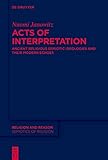Acts of Interpretation : Ancient Religious Semiotic Ideologies and Their Modern Echoes / Naomi Janowitz.
Material type: TextSeries: Religion and Reason : Theory in the Study of Religion ; 66Publisher: Berlin ; Boston : De Gruyter, [2022]Copyright date: ©2022Description: 1 online resource (X, 160 p.)Content type:
TextSeries: Religion and Reason : Theory in the Study of Religion ; 66Publisher: Berlin ; Boston : De Gruyter, [2022]Copyright date: ©2022Description: 1 online resource (X, 160 p.)Content type: - 9783110768596
- 9783110768626
- 9783110768602
- 210.14 23/eng/20220608
- BL65.L2 J35 2022
- online - DeGruyter
- Issued also in print.
| Item type | Current library | Call number | URL | Status | Notes | Barcode | |
|---|---|---|---|---|---|---|---|
 eBook
eBook
|
Biblioteca "Angelicum" Pont. Univ. S.Tommaso d'Aquino Nuvola online | online - DeGruyter (Browse shelf(Opens below)) | Online access | Not for loan (Accesso limitato) | Accesso per gli utenti autorizzati / Access for authorized users | (dgr)9783110768602 |
Frontmatter -- Acknowledgments -- Contents -- Introduction: Explaining and Misunderstanding How Signs Work -- 1 Ancient Ideologies of Ineffability and Their Reverberations -- 2 Speech Acts and Divine Names: Comparing Ancient and Modern Linguistic Ideologies of Performativity -- 3 Creating the Forbidden Sign: Ancient and Modern Debates about Proper Representation -- 4 Late Antique and Modern Semiotic Models of Letter and Spirit -- 5 A Semiotic Approach to Ascent Liturgies -- 6 The Indeterminate Meaning of Burning Man Rituals and Modern Notions of Spirit -- Conclusions -- Appendix 1: Ninja and Tijuana Vows -- Appendix 2: Marry Yourself Vows -- Bibliography -- Index of Persons -- Index of subjects
restricted access online access with authorization star
http://purl.org/coar/access_right/c_16ec
Ancient authors debated proper verbal and non-verbal signs as representations of divinity. These understanding of signs were based on ideas drawn from language and thus limited due to a their partial understanding of the multi-functionality of signs. Charles S. Peirce’s semiotics, as adapted by anthropological linguists including Michael Silverstein, better explains the contextual linkages ("performativity") of ancient religious signs such as divine names. Sign meaning is always dependent on processes of interpretation and is always open to reinterpretation. Focusing on these processes permits a more detailed analysis of the ancient evidence. Examples are drawn from ancient Israelite verbal and non-verbal divine representation, the apostle Paul’s linguistic letter/spirit model, Christian debates about the limits of language to best represent the deity, Josephus’ aniconic advertisement of Jewish rites, the multi-layered divine representations in the Dura-Europos synagogue, the diverse "performativity" of Jewish ascent liturgies, and—the single modern example—the role of art at Burning Man. Divine representation is the basis for ritual efficacy even as sign meaning is a constant source of contention.
Issued also in print.
Mode of access: Internet via World Wide Web.
In English.
Description based on online resource; title from PDF title page (publisher's Web site, viewed 02. Mai 2023)


